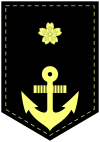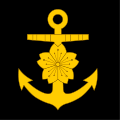Naval ranks of the Japanese Empire during World War II
.svg.png)
| ||||||||||||||||||||
The following graphs present the rank insignia of the Imperial Japanese Navy during World War II. These designs were used from 1931 onwards.
Commissioned officer ranks [1]
Cap badges:
| All-forces ranks | IJN insignia (sleeve) | IJN insignia (collar & shoulder boards) |
|---|---|---|
| 大元帥、海軍大将 Dai-gensui-Kaigun-Taishō (Grand-marshal- admiral) |
.jpg) |
 |
| OF-10 元帥、海軍大将 Gensui-kaigun-taishō (Marshal-admiral) |
  (Same insignia as admiral; with enamelled breast badge) |
 |
| OF-9 海軍大将 Kaigun-taishō (Admiral) |
 |
 |
| OF-8 海軍中将 Kaigun-chūshō (Vice-admiral) |
 |
.gif) |
| OF-7 海軍少将 Kaigun-shōshō (Rear-admiral) |
 |
.gif) |
| OF-5 海軍大佐 Kaigun-daisa (Captain) |
 |
.gif) |
| OF-4 海軍中佐 Kaigun-chūsa (Commander) |
 |
 |
| OF-3 海軍少佐 Kaigun-shōsa (Lieutenant-commander) |
.gif) |
.gif) |
| OF-2 海軍大尉 Kaigun-daii (Lieutenant) |
 |
.gif) |
| OF-1 海軍中尉 Kaigun-chūi (Sub-lieutenant/Lieutenant junior grade) |
.gif) |
.gif) |
| OF-1 海軍少尉 Kaigun-shōi (Ensign) |
.gif) |
.gif) |
The branch of the Navy in which non-executive personnel served was indicated by the color of cloth place as a background to the cuff stripes, on both sides of the gold lace on the shoulder straps, and as longitudinal piping on the colloar patches. Midshipmen and cadets of the corps wore a colored anchor on the cap.[2]
| Color | Branch |
|---|---|
| Violet | Engineers |
| Brown | Ship and engine construction |
| Purple-brown | Ordnance construction |
| Red | Medical |
| Pale green | Legal |
| White | Paymasters |
| Black | Survey officers |
| Light blue | Aviation officers and hydrographers (Imperial Japanese Navy Air Service) |
| Green | Chief carpenters (warrant officer) |
| Grey-blue | Band master (warrant officer) |
Cadet and warrant officer ranks
| All-forces ranks | IJN insignia |
|---|---|
| OR-9 兵曹長 Heisōchō (Warrant officer) |
Single 1/4 in. gold stripe with loop. |
| OF(D)海軍少尉候補生 Kaigun shōi kōhosei (Midshipman) |
Single 1/4 in. gold stripe |
Enlisted ranks
All warrant and commissioned officer ranks had the same names as their army counterparts. For non-commissioned officers and enlisted, the naming changed in 1942. The first name is before, the second after that date. Both of them were different from the army names, but were equal in rank.
| Before 1942 | After 1942 | |
|---|---|---|
| Non-commissioned officers 下士官 (Kashikan) - selected from conscripts and given one year of training in the Navy NCO Academy. | ||
| OR-7 一等兵曹 Ittōheisō Petty officer first class | OR-7 上等兵曹 Jōtōheisō Chief petty officer |  |
| OR-6 二等兵曹 Nitōheisō Petty officer second class | OR-6 一等兵曹 Ittōheisō Petty officer first class |  |
| OR-5 三等兵曹 Santōheisō Petty officer third class | OR-5 二等兵曹 Nitōheisō Petty officer second class |  |
| Enlisted/seamen 水兵 (Suihei) | ||
| OR-4 一等水兵 Ittōsuihei Seaman first class | OR-4 水兵長 Suiheichō Leading seaman |  |
| OR-3 二等水兵 Nitōsuihei Seaman second class | OR-3 上等水兵 Jōtōsuihei (senior seaman) Able seaman |  |
| OR-2 三等水兵 Santōsuihei Seaman third class | OR-2 一等水兵 Ittōsuihei (seaman first class) Ordinary seaman |  |
| OR-1 四等水兵 Yontōsuihei Seaman fourth class | OR-1 二等水兵 Nitōsuihei (seaman second class) Seaman recruit |  |
See also
- Army ranks of the Japanese Empire during World War II
- Comparative military ranks
- Military of Japan
- Military rank
References
- ↑ Rosignoli, Guido (1980). Naval and Marine Badges and Insignia of World War 2. Blandford Colour Series. Link House, West Street, Poole, Dorset, BH15 1LL: Blandford Press Ltd. pp. 152–153.
- ↑ Rosignoli, Guido (1980). Naval and Marine Badges and Insignia of World War 2. Blandford Colour Series. Link House, West Street, Poole, Dorset, BH15 1LL: Blandford Press Ltd. pp. 152–153.

